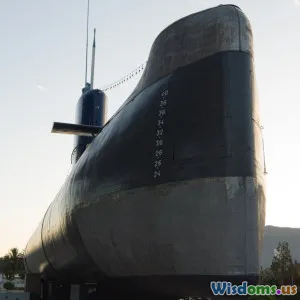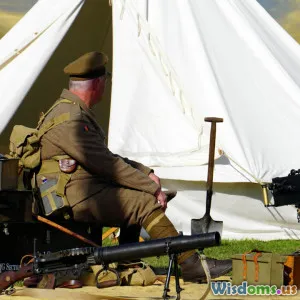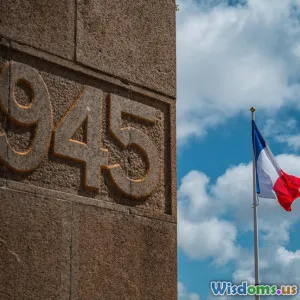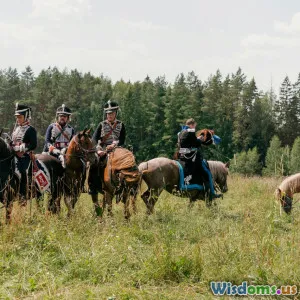
Comparing Military Tactics of England and France in the 1600s
13 min read An in-depth analysis of 17th-century English and French military tactics revealing distinct strategic philosophies and battlefield innovations. (0 Reviews)
Comparing Military Tactics of England and France in the 1600s
The 17th century, often called the early modern period, was a transformative era for European military doctrine and battlefield strategy. Among the leading powers, England and France showcased distinctly different yet evolving tactics in their armies during this period. The century was marred by intermittent wars — including the Thirty Years’ War, English Civil War, and various Franco-Spanish conflicts — where tactical ingenuity was paramount. This article explores the evolution and characteristics of military tactics used by both England and France in the 1600s, uncovering how geography, political climate, and military leadership influenced their approach to warfare.
The Context: Warfare in the 1600s
The 1600s were marked by the gradual transition from medieval to early modern warfare characterized by the rise of gunpowder, disciplined infantry, and professional standing armies. Castles and heavy cavalry slowly gave way to musketeers, pikemen, and cannon-based artillery. France and England were central players in this transition:
- England was finding its feet as a naval power and experimenting with infantry reforms amidst civil strife.
- France, under the Bourbon monarchy, was centralizing power and developing its famed military machine.
Both kingdoms adapted their military tactics in response to evolving technology and battlefield lessons, offering us a lens to analyze how warfare strategy developed along different ideological and practical lines.
England’s Military Tactics: Adaptation and Discipline
The Legacy of the English Civil War
One of the defining military events in 17th-century England was the English Civil War (1642–1651) between Royalists and Parliamentarians. This conflict acted as a laboratory for military reform, primarily under Sir Thomas Fairfax and Oliver Cromwell, whose New Model Army revolutionized English tactical doctrine.
-
Professionalism and Unity: The New Model Army was among the first professional standing armies, enforcing strict discipline and meritocratic leadership rather than loyalty by birth.
-
Combined Arms and Firepower: Tactical doctrine favored disciplined volley fire by musketeers combined with pikemen forming defensive squares, a format inspired by continental tactics but refined for English conditions.
-
Flexibility and Mobility: Unlike some more rigid formations, English troops adopted more flexible deployments to respond dynamically to rapidly shifting battlefield conditions.
England’s Naval Influence on Land Tactics
With England’s growing naval prowess, there was a cross-pollination between sea and land tactics. For example, the emphasis on coordination, supply lines, and logistical support stemmed from naval traditions that influenced later military doctrine.
Tactical Structure: Battalion-based Formations
English infantry tactics often revolved around battalion formations mixing pikemen and musketeers, arranged to leverage the muskets’ increasing range. The famous Cromwellian “Ironsides” cavalry were notably disciplined, emphasizing aggressive charges combined with tight cohesion.
Oliver Cromwell once said — “God is my witness, never shall I carry a weapon in the sight of an English soldier.” This underlined the drive toward morale, discipline, and psychological warfare as key tactical aspects.
France’s Military Tactics: Centralization and Innovation
Cardinal Richelieu and Military Reform
Early in the century, Cardinal Richelieu steered France toward centralized control over its military forces, creating a more unified army under royal command and directing innovations technically and doctrinally.
-
Professional Standing Army: France invested heavily in permanent standing armies, incorporating foreign mercenaries and native troops into well-organized regiments.
-
Artillery and Engineering Expertise: French tactics increasingly valued artillery efficiency and siegecraft, reflective of engineers such as Sébastien Le Prestre de Vauban who revolutionized fortifications and siege techniques.
The French Brigade System
While England deployed battalion tactics, France emphasized brigade formations, which involved grouping multiple regiments for flexible but concentrated maneuver. This system allowed rapid massing of troops and effective response to battlefield variables.
Combined Use of Pike and Shot
French battlefield tactics generally maintained the traditional pike and shot model—a close integration of pikemen and musketeers. However, French pikemen were often more aggressively used to hold the line or press attacks fixedly, relying on superior numbers and intense discipline.
Emphasis on Cavalry and Shock Tactics
French cavalry tactics emphasized shock, with heavy cuirassiers and gens d’armes charging in coordinated attacks aiming to break enemy lines decisively. Light cavalry (“hussars”) provided scouting and harassment, affording a balanced cavalry repertoire.
The Legacy of the Thirty Years’ War
France’s extended involvement in the Thirty Years’ War (1618-1648) exposed its army to diverse fighting styles, encouraging tactical innovations and the adoption of flexible approaches to siege and field warfare from various European traditions.
Comparative Analysis
| Aspect | England | France |
|---|---|---|
| Army Organization | New Model Army: professional, meritocratic | Centralized royal standing army with regimental structure |
| Tactical Unit Structure | Battalion-centric with integrated pikemen and musketeers | Brigade formations grouping regiment(s) |
| Infantry Tactics | Disciplined volley fire, flexible formations | Pike and shot balanced with aggressive use of pikemen |
| Cavalry | The disciplined, versatile “Ironsides” cavalry | Heavy shock cavalry supported by light reconnaissance cavalry |
| Artillery & Siege | Less dominant, improving through later 1600s | Advanced fortifications and siege tactics (Vauban’s influence) |
| Notable Battles | Battle of Naseby (1645), where discipline and firepower won | Battle of Rocroi (1643), demonstrating cavalry prowess |
Key Examples to Highlight
-
Battle of Naseby (1645): England’s New Model Army displayed superior coordinated musket volley fire and discipline that decimated the Royalist forces.
-
Battle of Rocroi (1643): Marked a turning tide for France; French infantry and cavalry decisively broke Spanish tercios, showcasing the effectiveness of their integrated tactics.
Innovations and Legacy
Both nations influenced broader military doctrine beyond their borders:
-
England’s merit-based command and professional standing army prefigured modern military organization and emphasized psychological elements such as morale and training.
-
France’s technical advances in artillery and siegecraft, alongside the brigade system, shaped continental European armies for centuries. Vauban’s engineering legacy, especially, was internationally renowned.
Conclusion: Divergent Paths Toward Modern Warfare
The military tactics of England and France in the 1600s reveal fascinating contrasts shaped by political needs, institutional reforms, and cultural traditions. England embraced discipline, professionalism, and flexible infantry tactics influenced by internal civil conflict and naval logistic systems. Meanwhile, France centralized military power, emphasizing massed formations, combined arms with aggressive cavalry, and technical mastery in artillery and siege warfare.
These varying approaches reflect a broader narrative of early modern military evolution. England’s legacy lay in creating effective, disciplined standing armies that inspired future republics. France’s contribution was its influence on continental armies via strong centralization, technical innovation, and coordinated field formations, laying groundwork for the military dominance it would enjoy under Louis XIV.
Understanding their contrasting methods enriches our perspective on the nature of early modern warfare and the foundations of contemporary military principles. The 1600s were not just a time of turbulent conflict but also of strategic experimentation that shaped the future of European and global military arts.
References & Further Reading
- Mark C. Fissel, The Bishops’ Wars: Charles I’s Campaigns Against Scotland, 1638–1640, Cambridge University Press, 1994.
- Olaf van Nimwegen, The Dutch Army and the Military Revolutions, 1588–1688, Boydell Press, 2010.
- John A. Lynn, The Wars of Louis XIV 1667-1714, Longman, 1999.
- David G. Chandler, The Art of Warfare in the Age of Marlborough, Spellmount, 1990.
- Geoffrey Parker, The Military Revolution: Military Innovation and the Rise of the West, 1500–1800, Cambridge University Press, 1996.
Image suggestion: Illustrations showing English pikemen and musketeers at Naseby and French cavalry at Rocroi.
Rate the Post
User Reviews
Popular Posts

















